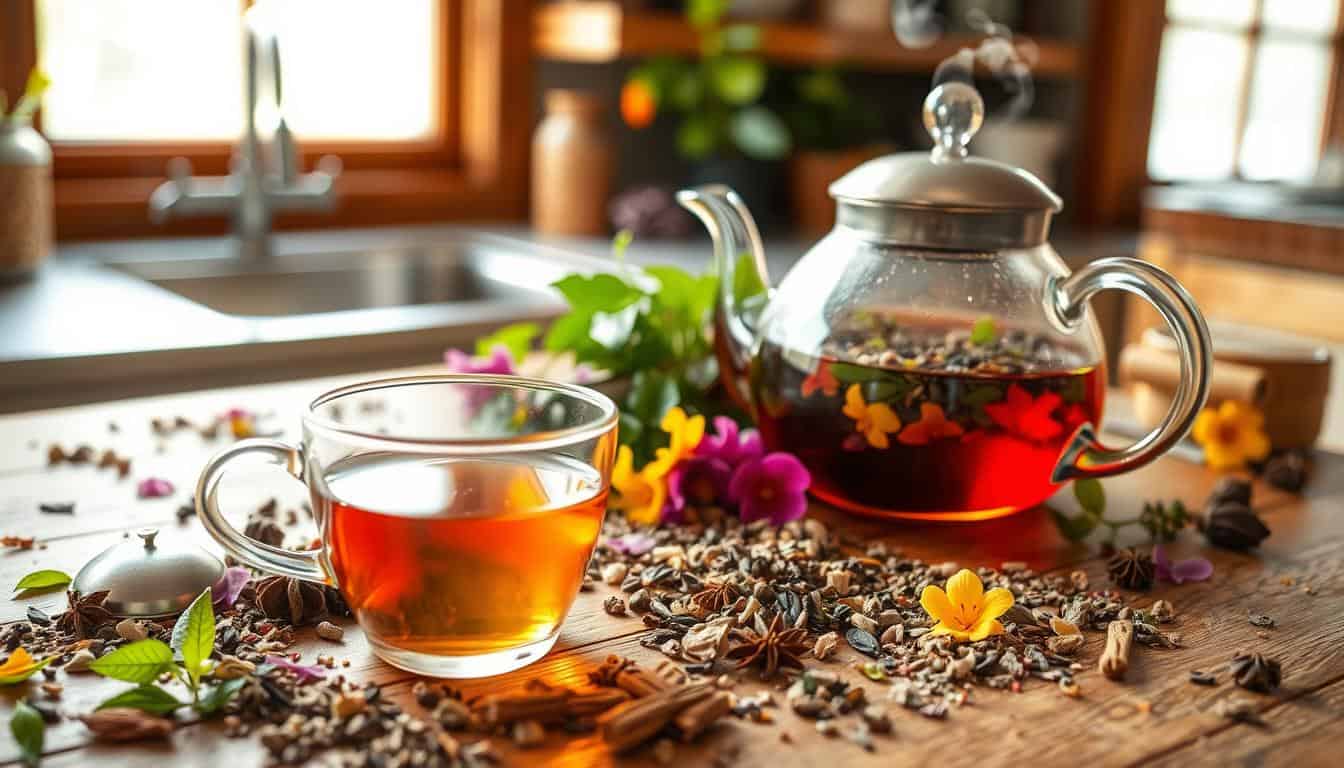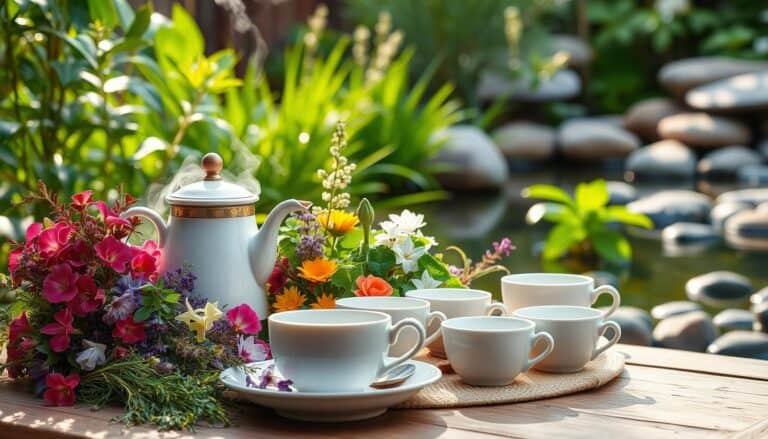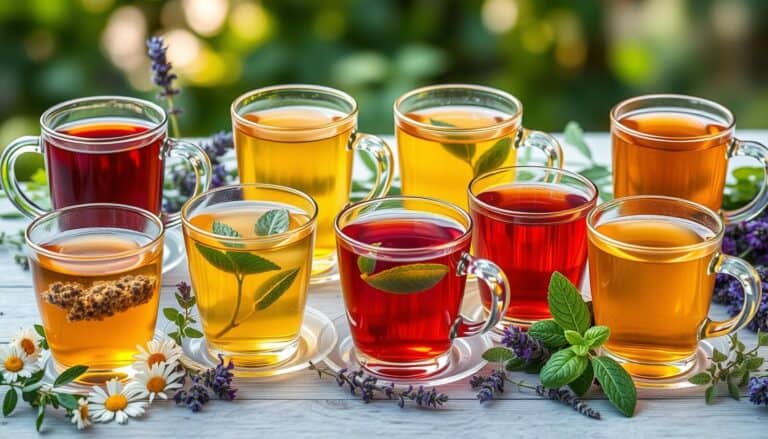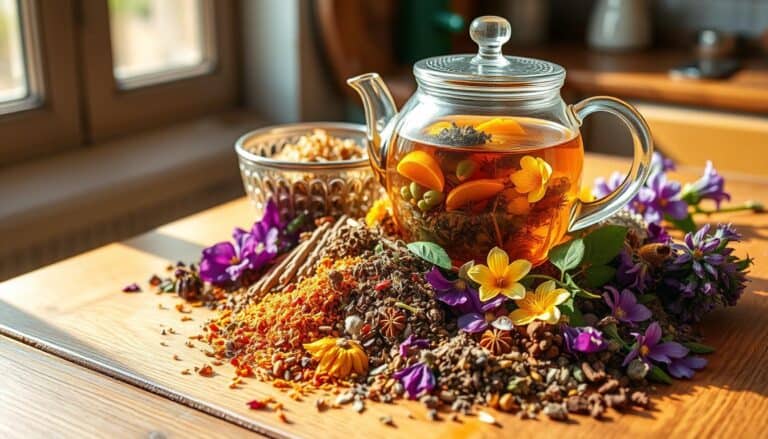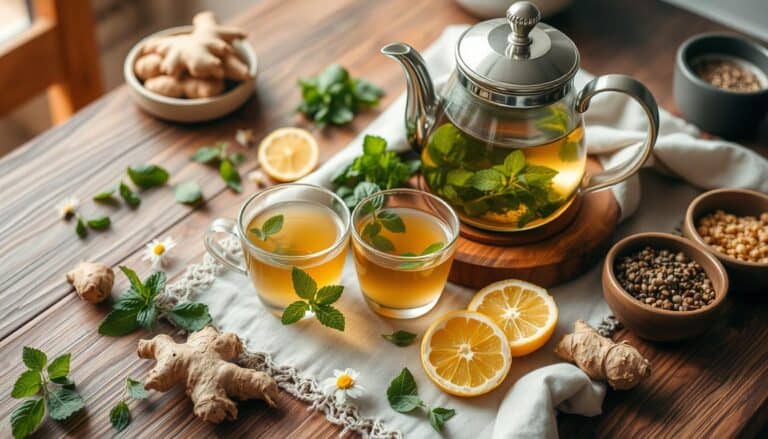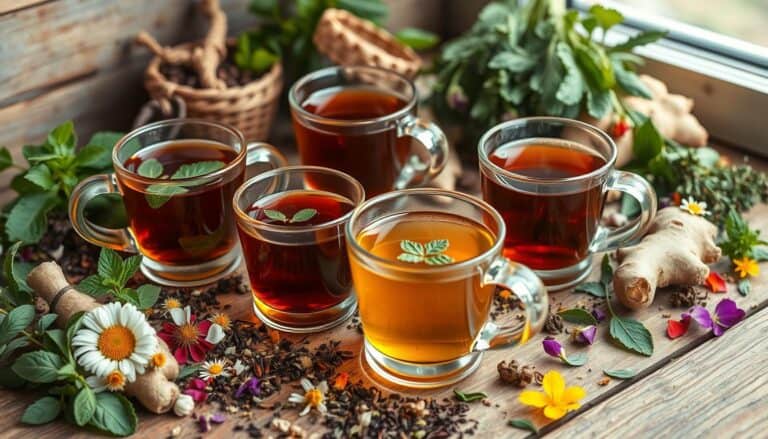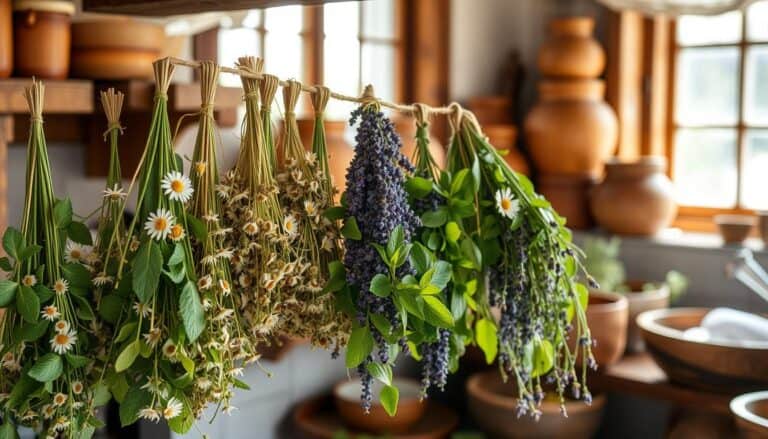The Perfect Herbal Tea Steeping Guide for Beginners
This post may contain affiliate links which means I may receive a commission for purchases made through links at no extra cost to you. I only recommend products I truly believe in. Thank you for your support!
Exploring herbal tea is a journey of taste and wellness. It’s not just about making a drink. It’s a way to connect with nature’s gifts.
For those new to tea, diving into herbal teas can change your daily routine. Unlike regular teas, herbal infusions come in many flavors and may offer health perks.
This guide will teach you the basics of herbal tea. You’ll learn how to pick the best ingredients and steep times. Soon, you’ll be making tasty and healthy herbal drinks with ease.
Herbal tea is great for relaxation, health, or just enjoying a tasty drink. Let’s start this flavorful adventure together. We’ll learn how to make amazing herbal teas.
Introduction to Herbal Tea Varieties
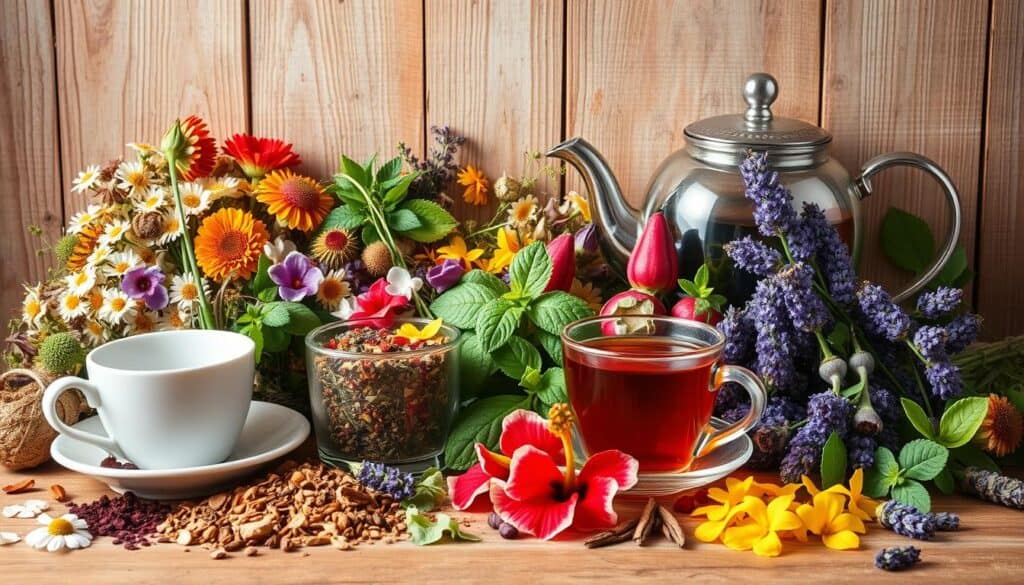
Exploring herbal tea is exciting for those who love tea and wellness. A good guide shows the variety of flavors and health benefits in each cup.
Discovering the Spectrum of Herbal Teas
Herbal tea blending introduces a world of natural wellness and taste. Unlike traditional teas, herbal teas come from many plants with special properties.
- Chamomile: Known for calming properties and anxiety reduction
- Lavender: Offers aromatherapeutic benefits and relaxation support
- Peppermint: Supports digestive health and provides refreshing flavor
- Milky Oat Tops: Rich in minerals and supports nervous system function
Popular Herbal Ingredients and Their Wellness Benefits
Artisanal herbal tea crafting requires knowing each ingredient’s special traits. Different herbs offer unique flavors and health benefits:
- Nettle Leaf supports joint health
- Lemon Balm reduces tension and aids digestion
- Turmeric with Ginger supports healthy inflammatory response
- Roasted Dandelion Root gently stimulates liver function
Creating your own herbal tea blends lets you customize your wellness journey. You can mix flavors and benefits that fit your needs.
Essential Tools for Brewing Herbal Tea
Mastering herbal tea preparation starts with the right tools. The journey of brewing herbal infusions begins with choosing the right equipment. These tools enhance the tea-making experience and bring out the best flavors from your herbs.
Choosing the Right Teapot or Infuser
Choosing the perfect brewing vessel is key for great herbal tea. Different materials have unique benefits for brewing herbal tea:
- Glass teapots: Let you see the steeping process
- Ceramic mugs with built-in infusers: Great for single servings
- French presses: Perfect for loose leaf herbal blends
- Stainless steel infusers: Durable and easy to clean
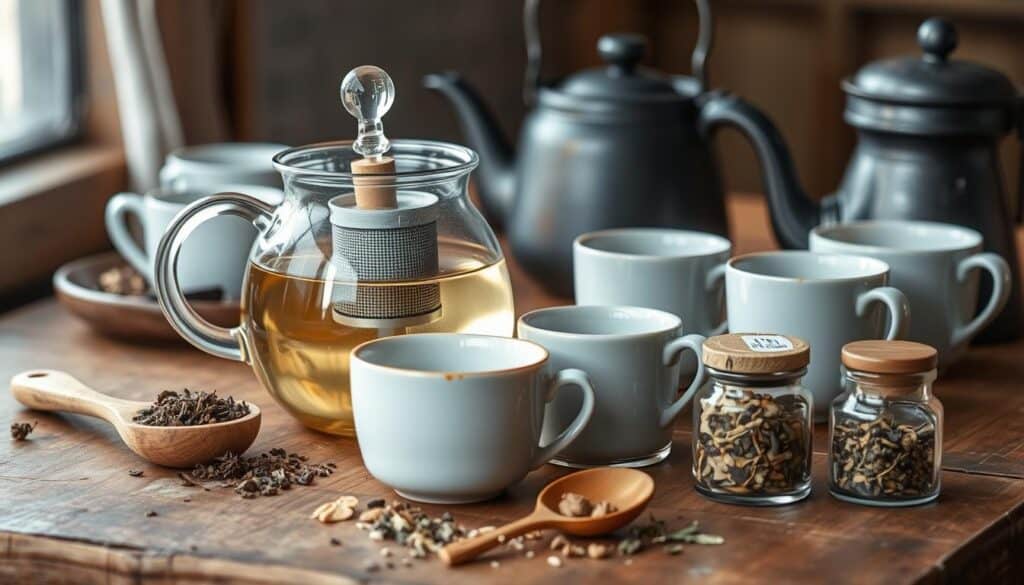
Recommended Accessories for Tea Lovers
Enhance your brewing experience with these essential accessories:
| Accessory | Purpose | Recommended Use |
|---|---|---|
| Digital Kettle | Precise Water Temperature | Brewing at 200°F |
| Tea Scoop | Accurate Measurement | 1.5 tsp per 8 oz water |
| Tea Timer | Consistent Steeping | 20 minutes maximum |
| Fine Mesh Strainer | Herb Filtration | Remove loose herbs |
Investing in quality tools makes brewing herbal tea a delightful ritual. Your accessories will help you brew perfect herbal infusions with rich flavors and optimal benefits.
The Steeping Process Explained
Learning about herbal tea steeping times and temperatures is key. It helps get the best flavor and health benefits from your tea. Knowing how to make tea can turn a simple drink into a special experience.
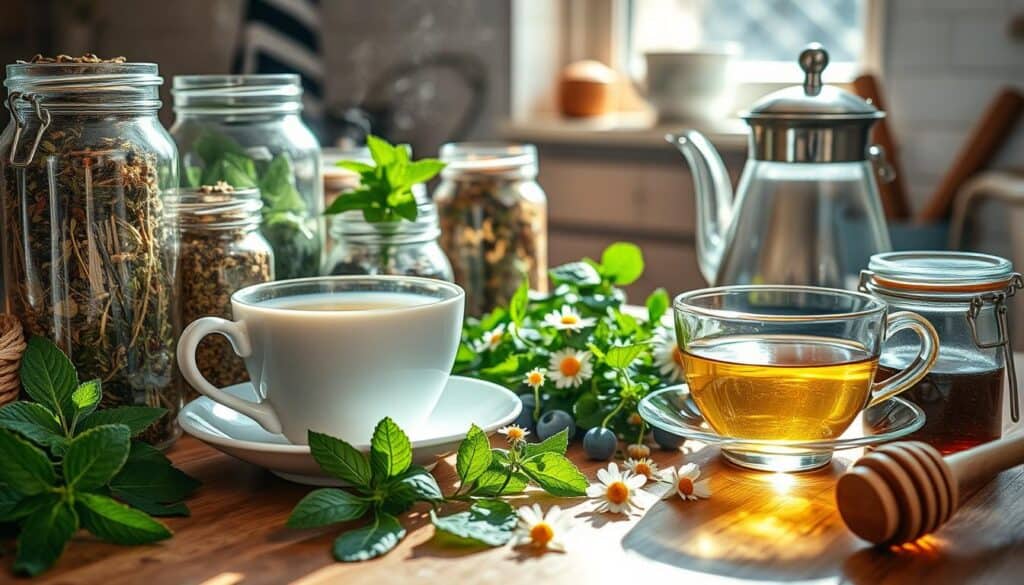
Exceptional herbal tea comes from precision and skill. Each herb needs its own steeping conditions to shine.
Water Temperature Insights
Most herbal teas do best with boiling water at 212°F (100°C). Water temperature greatly affects the tea’s taste and strength. Here’s a quick guide to herbal tea temperatures:
- Robust herbs: Full boil (212°F)
- Delicate flowers: Slightly cooled boiling water
- Roots and bark: Extended brewing at high temperatures
Ideal Steeping Times for Different Herbs
Steeping times for herbal teas vary. A general guide helps avoid over or under-steeping:
- Chamomile: 5-7 minutes
- Peppermint: 5-7 minutes
- Hibiscus: 5-10 minutes
- Ginger: 7-10 minutes
Tea lovers can tweak steeping times to their liking. Longer steeping makes flavors stronger but can be bitter. Shorter steeping makes the tea weaker.
Cold Brewing Alternative
Cold brewing is a smooth alternative. Steep herbs in cold water for 8-12 hours in the fridge. It makes a milder, less bitter tea that keeps herbal flavors.
The herbal tea temperature guide is your key to perfect brewing. Try different times and temperatures to find your perfect cup.
How to Select Quality Herbal Tea
Finding the perfect herbal tea is more than just picking a random package. Your journey starts with understanding key selection criteria. These ensure a delightful brewing experience.
Loose Leaf vs. Tea Bags: Making the Right Choice
The debate between loose leaf and tea bags is key when choosing herbal teas. Loose leaf herbal tea usually offers better quality. It has several advantages:
- More expansive herb distribution
- Fuller, richer flavor profiles
- Higher essential oil retention
- Multiple steeping potential
Recognizing Freshness and Flavor
Fresh artisanal herbal tea shows itself through sensory evaluation. Look for these key indicators:
- Vibrant color: Rich, deep hues suggest quality herbs
- Strong aroma: Distinct, pleasant scents without mustiness
- Minimal dust: Whole herb pieces indicate better processing
When buying, check packaging dates. Store teas in airtight containers away from light and moisture. Use loose leaf herbal tea within one year for the best flavor and potency.
Expert Purchasing Tips
Buy 4-6 ounces if you drink tea often. Choose opaque zip-top bags to protect against environmental factors. Remember, quality is more important than quantity in artisanal herbal tea.
Flavor Pairings and Enhancements
Artisanal herbal tea blending is a fun culinary journey. It turns simple tea into a rich sensory experience. By mixing different herbs and ingredients, you can make unique flavors that excite your taste buds.
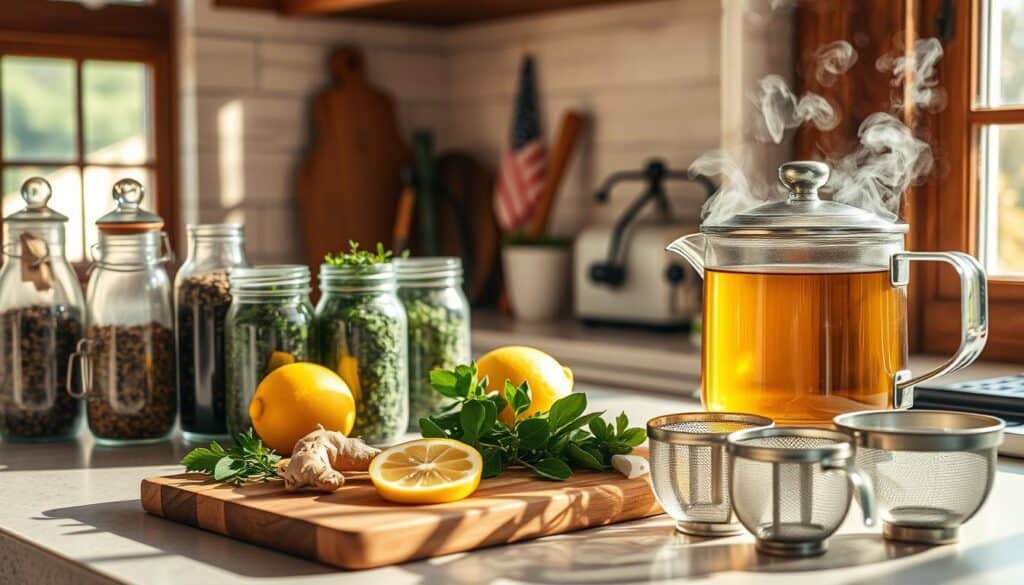
Combining Herbs for Unique Blends
Herbal tea blending lets you explore endless flavor combinations. Here are some expert tips:
- Calming Blend: Chamomile with lavender for relaxation
- Energizing Blend: Peppermint with ginger for a refreshing boost
- Evening Blend: Lemon balm with passionflower for peaceful nights
Sweeteners, Milk, and Other Additions
Make your herbal tea even better by trying these additions:
- Natural Sweeteners:
- Raw honey
- Maple syrup
- Stevia
- Milk Options:
- Almond milk
- Oat milk
- Coconut milk
- Flavor Enhancers:
- Cinnamon stick
- Fresh lemon
- Dried fruit
Pro tip: Begin with small amounts when blending herbal teas. Each ingredient should enhance, not overwhelm, the main herbal tastes. Aim for a balanced flavor that suits your taste.
Troubleshooting Common Steeping Issues
Mastering herbal tea preparation can be tough, even for tea lovers. Knowing how to steep tea helps you avoid common mistakes and make the perfect cup every time.
Tea brewing is an art that needs precision and care. Spotting and fixing common steeping problems can make your tea experience go from okay to amazing.
Identifying Over-Steeped Tea
Over-steeping can mess up the flavors of your herbal tea. Here are signs of an over-steeped brew:
- Excessive dark color
- Bitter or astringent taste
- Unpleasant, overpowering flavor profile
Tips for Adjusting Strength and Flavor
Getting your tea just right means knowing how to tweak its strength and taste. Here are some tips:
- For strong tea: Reduce steeping time
- For weak tea: Increase herb quantity or steeping duration
- Dilute over-strong tea with hot water
| Tea Type | Recommended Steeping Time | Water Temperature |
|---|---|---|
| Green Herbal Tea | 1-3 minutes | 160-180°F |
| Black Herbal Tea | 3-5 minutes | 200-212°F |
| Chamomile | 5-7 minutes | 190-200°F |
Remember, each herbal tea is different. Try different steeping times and temperatures to find your favorite brew.
Conclusion: Enjoying Your Herbal Tea Journey
Your guide to herbal teas opens a world of flavors and wellness. Herbal tea blending is an art that invites endless creativity. Start by seeing each cup as a chance to find new tastes and health benefits.
Learning about herbal teas takes patience and curiosity. Begin with simple single-herb teas and then try more. Keep a journal to note your favorite blends and the flavors of different herbs. Remember, practice makes you a true tea lover.
The tea journey is more than brewing—it’s about wellness and tradition. Look for local tea shops, online groups, and workshops to learn more. By experimenting and learning, you’ll discover the deep world of herbal teas.
Experimenting with New Blends
Don’t be shy to mix different herbs. Your taste will grow as you try new combinations. This way, you’ll create blends that match your taste and health goals. The beauty of herbal tea blending is its endless possibilities.
Joining the Herbal Tea Community
Connect with other tea lovers through local groups or online forums. Sharing and learning from others can help you appreciate herbal tea more. Your journey with herbal teas is just starting—enjoy every sip!
